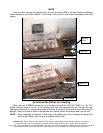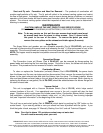
IMPORTANT! READ AND FOLLOW ALL INSTALLATION AND MAINTENANCE INSTRUCTIONS, INCLUDING
CLEANING THE UNIT AS SPECIFIED, AND REPLACING GASKETS ANNUALLY, AND PARTS AS NEEDED.
ENGLAND’S STOVE WORKS IS NOT RESPONSIBLE FOR ANY DAMAGE OR INJURY INCURRED DUE TO NEGLECT, OR DUE
TO UNSAFE INSTALLATION OR USAGE OF THIS PRODUCT. CALL TECHNICAL SUPPORT WITH QUESTIONS.
20
ASH REMOVAL AND DISPOSAL
IMPORTANT: While the amount of ash generated by this unit is not excessive compared to
log-burning woodstoves, keeping the unit clean and free of ash is essential
for
peak performance. Too much ash build-up hampers airflow and reduces the
unit’s efficiency, and can cause smoke-back. See the DVD for cleaning tips!
Daily Ash Maintenance
Press the “OFF” touch pad and allow the stove to shutdown (approx. five (5) minutes) prior to
opening the door. A long-handled screwdriver or long-handled putty knife can be used to scrape off
any build-up or crust in the burnpot area. Remove and clean the burnpot (See page 15). Daily
cleaning may not be required when burning wood pellets.
Ash Pan
NOTE: The ash pan must be locked in place when the unit is in operation.
NEVER operate the unit with the ash pan out or unsecured! This unit has an ash pan for more
convenient and hassle-free cleaning; to open, lift up on the handle, then pull the ash pan forward.
NOTE: There are two handles just above the ash pan. These control two access panels (one on
each side) inside the unit (in the bottom), to put ashes into the ash pan. Pull the handles toward you
to open the panels, push the ashes into the ash pan and then replace them, making sure that the
area under each plate is clear before closing it. The unit should be off and cooled before any ash
maintenance.
Semi-Weekly Ash Maintenance
NOTE: The Semi-Weekly Ash Removal maintenance should include the steps listed in this section
as well as the steps listed in the Daily Ash Maintenance section.
Twice each week: Shut the unit down by pressing the “OFF” pad and allowing the unit to go
through the complete Shut-Down cycle. Allow the unit to completely cool down and then remove the
ashes. The ashes should be placed in a non-combustible container with an airtight lid and should
always be placed on a non-combustible surface or on the ground until completely cooled and free of
hot cinders. Once the ash is removed, the burnpot should be given a thorough inspection. Remove
and clean the burnpot (See page 15). Check for any build-up in the front of the burn area. Clean
out all air holes - these air holes should be kept clean, as they supply combustion air under and
around the fuel. The Cradle assembly (in which burnpot rests) should also be thoroughly cleaned.
IMPORTANT: Ash build-up can cause the unit to malfunction.
Monthly Ash Maintenance
NOTE: The Monthly Ash Removal maintenance should include the steps listed in this section as
well as the steps listed in the Semi-Weekly AND the Daily Ash Maintenance sections.
Use a screwdriver or chisel and break any creosote build-up in the front of the unit, where the
pellets are fed into the burnpot from the Auger Tube. Also inspect your flue pipes, and remove ash
buildup from the clean-out tee.
Annual Maintenance
NOTE: The Annual Cleaning maintenance should include the steps listed in this section as well as
the steps listed in the Monthly, Semi-Weekly AND the Daily Ash Maintenance sections.
The stove and the flue system should be given a complete cleaning at the end of the heating
season. Remove the burnpot (See page 15), clean it thoroughly, and re-install it. In addition to the
cleaning mentioned for semi-weekly and monthly, the Combustion (exhaust) Blower should be
removed annually and the blower tube vacuumed of any ash build-up. When cleaning or replacing
the blower a new gasket (Part # PU-CBG) should be added between the blower flange and the steel
exhaust tube. See the DVD video included with this unit for cleaning tips!
As with any maintenance concerning this unit, be sure the unit is “OFF” and has completed the Shut-
Down cycle BEFORE beginning. Be aware that metal parts in the firebox can remain HOT long after
the fire has gone out and EVEN after the Shut-Down cycle is complete. Always use extreme caution
when handlin
g
potentiall
y
hot stove parts, even if
y
ou think the
y
should be cold.


















